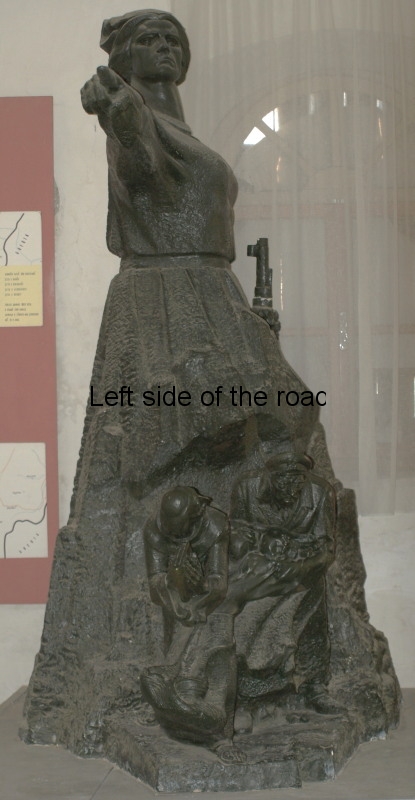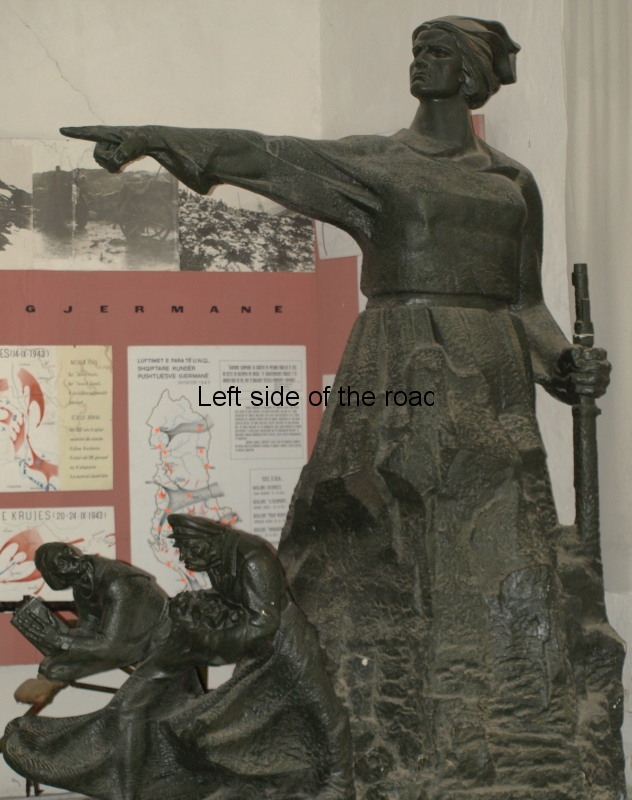Art as a means of promoting Socialism in Albania
Socialist mosaics and bas reliefs in Albania
The Albanian Cultural Revolution
Paintings, murals and sculptures of Socialist Albania
As with the mosaics and bas reliefs there are still many other examples of Socialist Realist art which it is possible to appreciate throughout the country. Sometimes they are on permanent show as they are out in the open air, others are in museums and art galleries. Many of these public areas of exhibition were vandalised post 1990 but there seems to be a trend, slow and often partial, to renovate some of these old exhibition spaces and to show what had been shown in pride of place in the past.
There are also a few reprints of articles published during the Socialist period. These have been reproduced in an attempt to give a wider view of the role of art in a Socialist society.
The Revolutionary Spirit in Albanian Painting and Sculpture.
This article first appeared in issue No 6, 1969 of the bi-monthly magazine New Albania which reported on the biennial exhibition of Figurative Art that was held in the National Art Gallery in Tirana earlier in the year.
1971 National Exhibition of Figurative Arts – Tirana
This article was first published in New Albania, No 6, 1971. It discusses the general idea of art in a socialist society, how the Albanians saw ‘Socialist Realism’ with mention of a handful of works (out of 180) that were displayed at the National Exhibition of Figurative Arts in Tirana in the autumn of 1971.
A Reflection of the Progress of our Figurative Arts
This article first appeared in New Albania, No 6, 1976. The bi-annual Figurative Arts Competition and Exhibition seemed to have been postponed from 1975 and instead took place in 1976 to coincide with the 35th Anniversary of the Founding of the Party of Labour of Albania.
Traditional Wedding Mural in Peshkopia
There’s a perception by some (normally the ignorant and anti-socialist) that any work of art created during the construction of Socialism is necessarily ‘Socialist Realist’ art. They don’t understand, or refuse to accept, that the construction of Socialism is a long task. When it comes to art this involves asking the people to challenge their view of what is going around them and to look at artistic works in a critical and thoughtful manner and that this involves the unmasking of the hidden messages in a painting, sculpture, film or any other creative endeavour. One such work that needs to be seen in this light is the Wedding Mural which covers one of the walls of the Korabi restaurant in the hotel of that name in the town of Peshkopia.
‘Death to Fascism’ Mural in the National Historical Museum, Tirana
The mural that covers the whole of one wall in the room of the National Historical Museum in Tirana that’s devoted to the War of Liberation against the invading fascists of 1939 to 1944 is one of the few which can still be appreciated at leisure by any visitor.
National Art Gallery ‘Sculpture Park’ – Tirana
Each time I’ve been to Tirana I’ve made it a point to visit the impromptu ‘sculpture park’ that has been created behind the National Art Gallery, just down from the main Skanderbreu Square in the centre of Tirana.
No, Vladimir Ilyich and Uncle Joe, you shall not go to the ball
No, Vladimir Ilyich and Uncle Joe, you shall not go to the ball seems to be the message given out by the pro-Western government in Albania. Vladimir Ilyich Lenin and Joseph Stalin are covered up by the Albanian reactionaries in an attempt to prevent them from spoiling their Independence party at the end of the month.
A new look, and a new resident, to the National Art Gallery ‘Sculpture Park’, Tirana
The ‘Sculpture Park’ behind the National Art Gallery in Tirana, has a new resident. Well, not so much a new resident but one who has been there for a few years but it is only recently that the authorities at the Art Gallery have decided to, literally, take off the wraps and reveal his presence to the world. The new resident is none other than Enver Hoxha, up to his death in 1985, First Secretary of the Party of Labour of Albania, Chairman of the Democratic Front of Albania and Commander-in-Chief of the Armed Forces.
Socialist Realist Paintings and Sculptures in the National Art Gallery, Tirana
This post will consist of images of the paintings (and a few sculptures) from the Socialist period of Albania’s past. The first floor of the National Art Gallery is almost now solely (with one notable exception, which I’ll come to later) devoted to the period before 1990 when things fell apart.
The ‘Archive’ Exhibition at the Tirana Art Gallery
This exhibition (that took place during the latter part of 2021) at the National Art Gallery in Tirana seemed to include virtually everything that had been in storage over the last 30 years. But calling it an exhibition was a bit of a misnomer. The word exhibition gives the impression that a bit of thought and consideration had been put into the mounting and display of a collection of art. That is supposed to be the art of a curator – although that was totally neglected in this case with all items placed in the room with consideration of context. This included works of art that had been damaged for whatever reason in the past.
Mother Albania Expelling The Priest and The Military
There are fine examples of Socialist Realism in the Armaments Museum in the Castle in Gjirokastra, but you might have to ask to go upstairs to enter this older part of the museum – especially out of the summer season. ‘Mother Albania Expelling The Priest and The Military’ is one such sculpture.
Emblem over Party HQ, Peshkopia
Originally my project to describe, in detail, the magnificent examples of Socialist Realist Art that are embodied in some of the lapidars throughout the country has now expanded as I’ve encountered other incidences of the unique manner used in Albania in its attempt to impart the message of Socialism. Whereas some of these are truly monumental in all senses of the word, such as the Drashovice Arch, many others are, if not actually hidden, difficult to find unless you are looking for them or, as in this case, are directed towards it by a knowledgeable local. The emblem over what used to be the Headquarters of the Party of Labour of Albania, in the mountain town of Peshkopia in the north-east of the country, is one such example.
Liri Gero and the 68 Girls of Fier
Many monuments, statues and lapidars from Albania’s Socialist period have suffered over the years, through outright political vandalism or just neglect. However, there has been a bit of a sea change in recent years but this has not come without its own problems. Here I want to develop the ideas of Albanian Socialist Realist art by looking at two works produced to commemorate the life of a young partisan woman, Liri Gero, and also a work in commemoration of 68 young women who also left their home town of Fier to join the partisans fighting the Fascist invaders.
The ‘Hanged Women’ of Gjirokastra
Tucked away at the top end of Sheshi Çerçiz Topulli (Square) in the old part of Gjirokastra is a small statue which you could easily miss. Next to the potted plants in front of the Tourist Information Office is a white stone statue, of the upper body, of two women. This is a representation of Bule Naipi and Persefoni Kokëdhima who were executed by the German Nazis in 1944. From that time they became known as the Hanged Women of Gjirokastra.
Traditional Musicians and Dancers
Although there are many monuments and statues that are overtly political, in that they commemorate events or people involved in national liberation struggles (whether that be against the Ottoman Empire or the Italian and German Fascists of World War Two) other aspects of Albanian life are also represented in various locations throughout the country. As Gjirokastra, in the Socialist period, had become the centre for periodic folklore festivals it’s not surprising to find a frieze depicting traditional musicians and dancers located there.
Enver Hoxha returns to Tepelene
…. although he probably never left, just ‘hiding’ for a while.
Almost thirty five years after his death and thirty years since the reaction was able to gain control in Albania it is very difficult to come across public images of Enver Hoxha, the leader of the country for just over forty years. In the 1990s the reactionaries needed to personalise any difficulties in the country and someone who had been dead for five years was an ideal candidate – even to the extent that Comrade Hoxha was considered responsible for events that had happened after his death. So he had to disappear from view.
Art as a means of promoting Socialism in Albania







